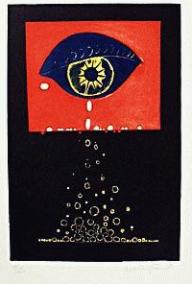Prints.
Printmaking techniques are generally divided into the following basic categories:
|  (Crying eye) |
Other types of printmaking techniques outside these groups include collagraphy, viscosity printing, and foil imaging. Collagraphy is a printmaking technique in which textured material is adhered to the printing matrix. This texture is transferred to the paper during the printing process. Contemporary printmaking may include digital printing, photographic mediums, or a combination of digital, photographic, and traditional processes.
Many of these techniques can also be combined, especially within the same family. For example Rembrandt's prints are usually referred to as "etchings" for convenience, but very often include work in engraving and drypoint as well, and sometimes have no etching at all.
